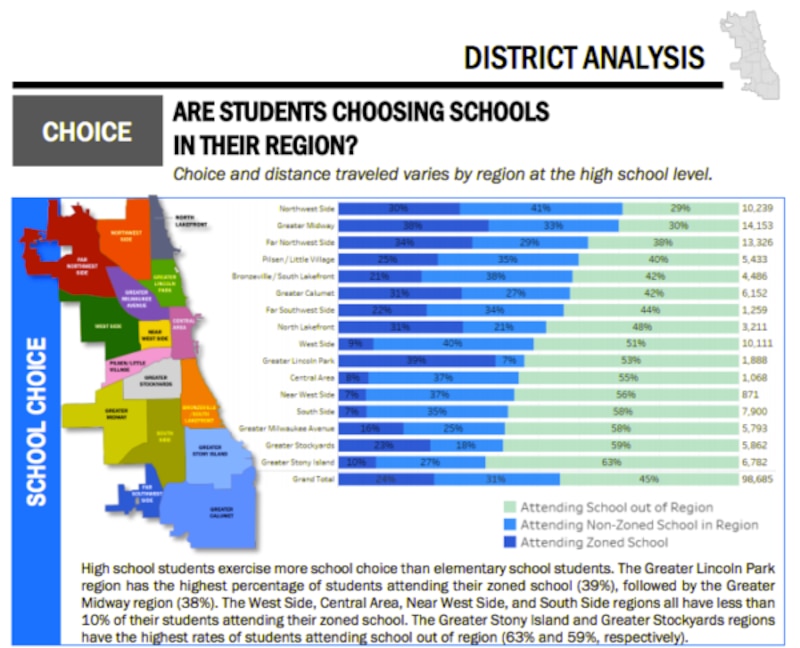Faced with an alarming report that lays bare shrinking enrollment and racial inequity, Chicago Public Schools must wrestle with some tough decisions. But Mayor Rahm Emanuel’s decision not to seek re-election means he won’t be the one addressing those issues for much longer.
Here are five questions raised by the report that Emanuel’s successor faces:
What about all those empty seats?

The Annual Regional Analysis, compiled by the school district and Kids First Chicago, projects plummeting enrollment to worsen in coming years. The district has more than 145,000 unfilled seats. By 2021 that gap could be more than 156,000 seats.
The next mayor will have to wrestle with that dismal trend just as Emanuel did in his first term, when he pushed the unpopular decision to shutter 50 schools. That move, research shows, exacted a heavy psychological toll on communities and hurt students’ academic achievement, especially in math. Yet, five years after the closings, the district still faces a massive surplus of classroom space, and is closing high schools in Englewood.
Some have argued that the district should change how it calculates space utilization at schools. They say the formula assumes an average class size of 30, and doesn’t adequately account for needs such as special education.
Community members have also called for an end to school closings, and said the city should consider creative solutions such as sharing space with social service agencies, redrawing attendance boundaries, and investing in academic programs to attract more students.
What can the city do to make neighborhood schools more attractive?
The analysis indicates that many families are skipping their neighborhood schools, including top-rated ones, for schools outside their area. Many schools suffer from low enrollment, and reside in communities where residents have cried out for more investments in neighborhood schools.
Kids First CEO Daniel Anello said the remedy should be to “improve quality and tell the community over and over again once you have.”
“There’s disparities terms of access and disparities in quality that need to be addressed,” he said. “The benefit of having a regional analysis is that people can see where those disparities are, and think about how we should invest in specific places to ensure the families there have access to high-quality options.”
Austin resident Ronald Lawless, who works as a community organizer and education consultant, was baffled to see that the West Side region, which includes Austin, has nearly 30,000 unfilled seats, about one in three of them at top-rated schools. Yet less than 40 percent of kids in the community attend their zoned neighborhood school. He said the district must combat stigma and misinformation that keeps people from neighborhood schools.
How can Chicago dig beyond school ratings to evaluate schools?
The analysis leans heavily on the annual school ratings policy. But no rating system can tell the whole story about school quality — and Chicago’s ratings rely primarily on standardized test scores and attendance, metrics that often reflect the socioeconomic makeup of the areas from which schools draw their students.
If the new mayor’s administration continues current practice, it will undoubtedly run into opposition from community groups that have been vocal about what they see as shortcomings.
Alexios Rosario-Moore, research and policy associate at the community group Generation All, said, “What we need is a qualitative assessment that involves universities, researchers, non-profit organizations and communities to determine what kind of programming that community needs.”
Anello of Kids First said no measure is perfect, but that Chicago’s school rating approach stacks up favorably against other districts. Yet, he conceded that the ratings don’t fully flesh out what it’s like in classrooms, and that “we can always be working to make it a better measure.”

How does school choice intersect with transportation?
For better or for worse, the analysis showed that more and more students are attending choice schools, meaning buildings outside their assigned attendance area.
Some students have to travel far for the academic programs and high-quality schools they want, especially those coming from high-poverty neighborhoods and communities of color.
Elementary students travel 1.5 miles on average, but the average distance to school for elementary students is highest (2.6 miles) in the Greater Stony Island region, which includes far South Side neighborhoods like Roseland, Chatham, Greater Grand Crossing and South Shore.

High school students travel 3.6 miles on average, but high schoolers in the Greater Stony Island area commute and average of 5 miles, tied for the longest community with the Far Southwest Side region that includes the Beverly and Morgan Park community areas.
Raise Your Hand spokeswoman Jennie Biggs said, “a choice-based system in a large, urban district that lacks universal, free transportation isn’t even providing the same set of choices to all kids.”
And Rosario-Moore of Generation All said he finds it surprising “that in a city so oriented around a school choice model that public transportation is not free to all students.”
How can Chicago better engage its rich arts community through public schools?
Chicago doesn’t offer its highly-desirable fine arts programs equitably across the city, and are most concentrated along the northern lakefront and downtown. Ingenuity Executive Director Paul Sznewajs praised Emanuel and schools chief Janice Jackson for investments in the arts and partnerships with cultural institutions and agencies, but said Chicago’s next mayor should do a better job of tapping into the city’s rich arts community.
He said that the Annual Regional Analysis focuses more narrowly on “a small sliver of arts in schools,” because it identifies available seats in what amounts to fine arts-focused magnet schools, of which he said there are probably 50-60 in the city.

But even if the school district were to double the number of arts magnet schools, Sznewajs said it must address equity, “so that when students walk into school, whether in Englewood or Ravenswood, that child can expect to the get the same things when it comes to the arts.”

